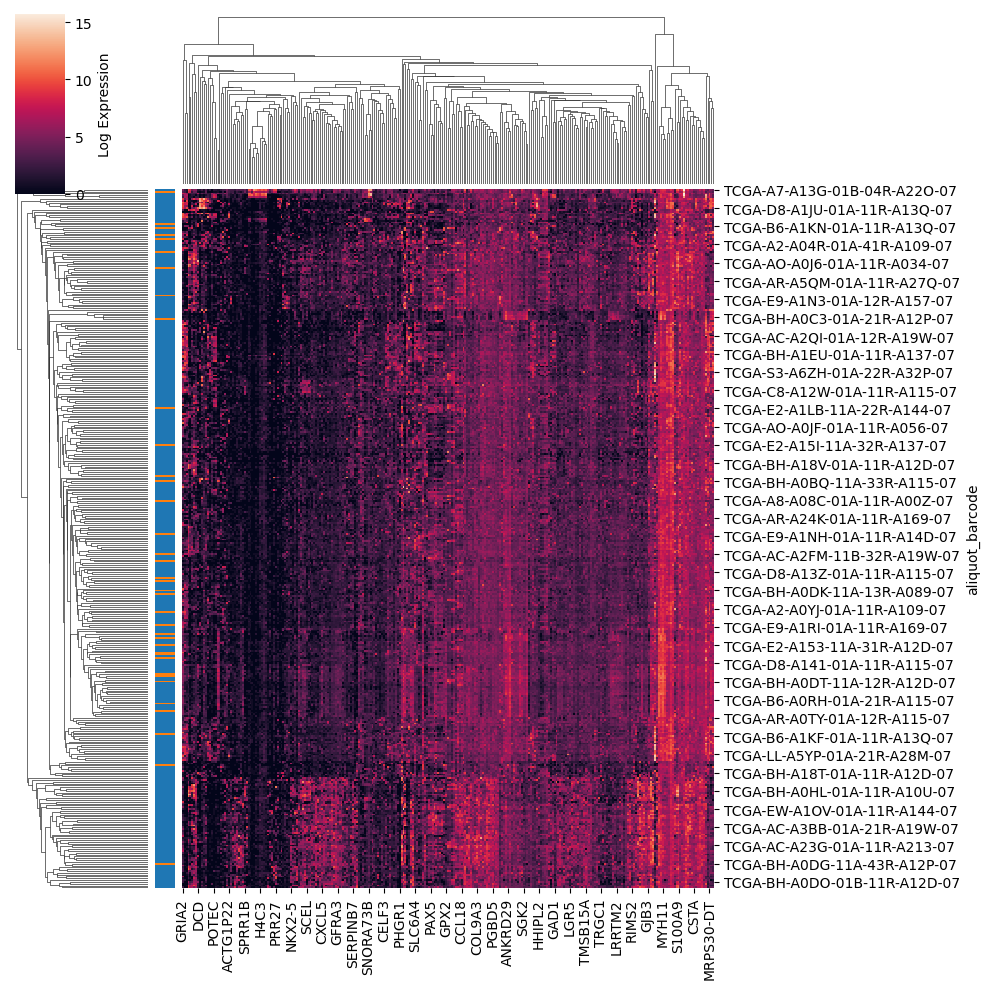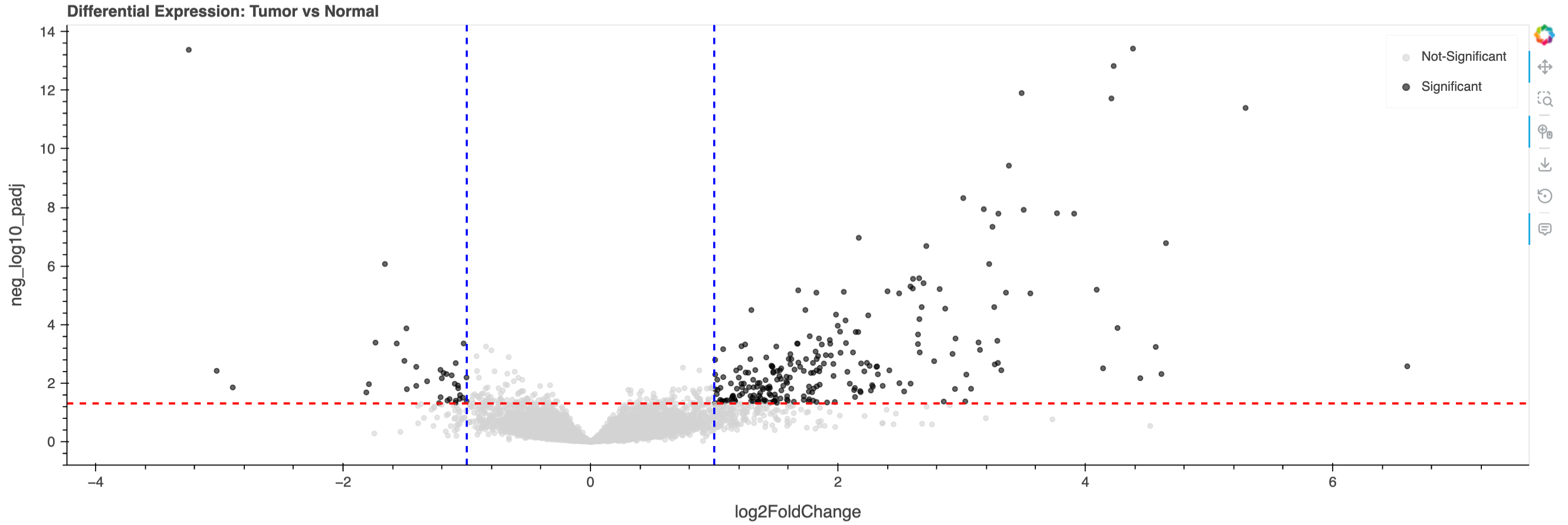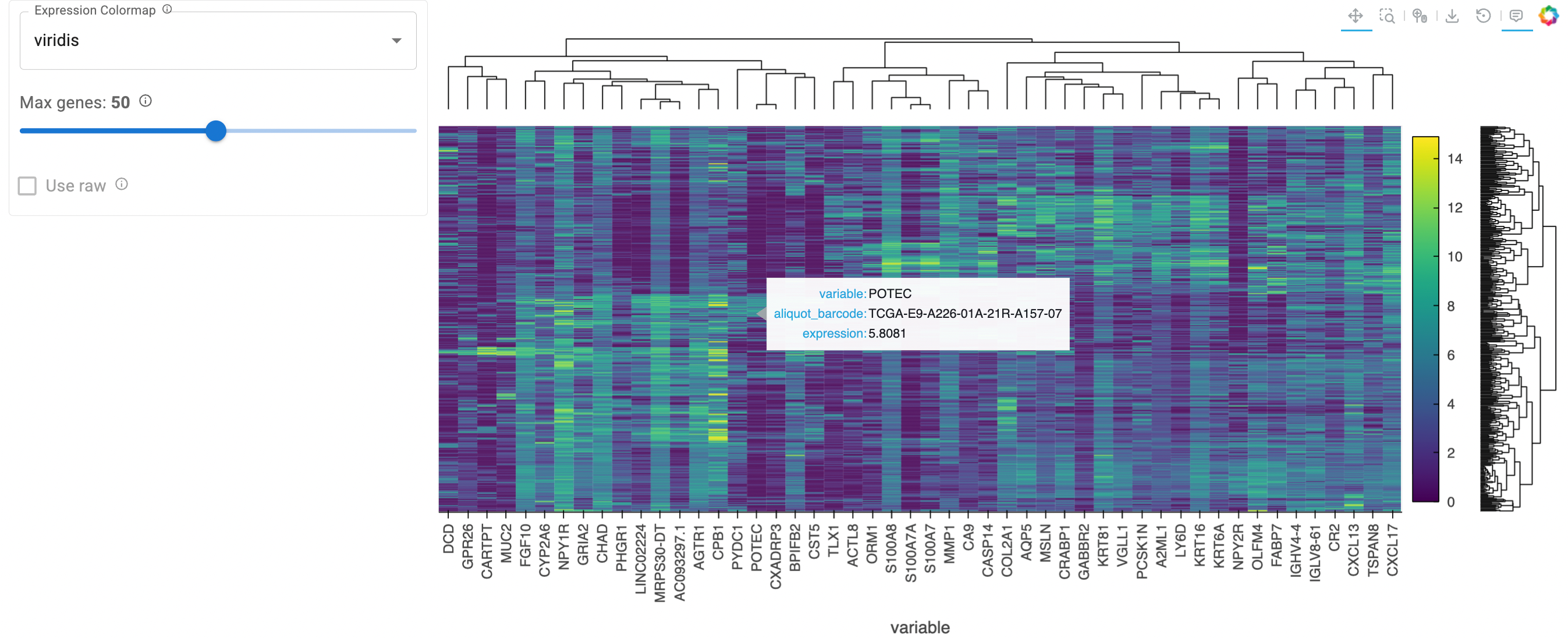Differential Expression in Bulk RNA-seq with AnnData#

Introduction#
The Cancer Genome Atlas (TCGA) has greatly impacted cancer research by providing comprehensive molecular profiles of over 11,000 tumors across 33 cancer types. This wealth of genomic data enables researchers to identify driver mutations, discover therapeutic targets, and understand the molecular basis of treatment response. However, analyzing TCGA’s massive datasets, containing thousands of samples with tens of thousands of genes, can be challenging. This workflow demonstrates how to perform differential expression analysis on TCGA data using modern Python tools and interactive HoloViz visualizations to derive biological insights from sequencing counts.
Why TCGA Analysis Matters for Cancer Research#
Differential expression analysis of TCGA data is fundamental for:
Identifying cancer biomarkers that distinguish tumor from normal tissue
Understanding oncogenic pathways by revealing coordinated gene expression changes
Discovering therapeutic vulnerabilities through identification of overexpressed targetable genes
Stratifying patient populations based on molecular signatures for precision medicine
Validating findings from smaller studies using TCGA’s large, well-annotated cohorts
This workflow guides you through a complete analysis pipeline, from loading TCGA breast cancer data to identifying significantly dysregulated genes, using tools that can scale to pan-cancer analyses.
from pathlib import Path
import anndata as ad
import holoviews as hv
import panel as pn
import hvplot.pandas # noqa
import numpy as np
import pooch
import pydeseq2.dds
import pydeseq2.ds
import scanpy as sc
import hv_anndata
from hv_anndata import ClusterMap
hv_anndata.register()
hv.extension("bokeh")
pn.extension()
pn.config.throttled = True
Part 1: Loading and Understanding TCGA Data Structure#
For this demonstration, we’ll analyze TCGA breast cancer (BRCA) samples that have been preprocessed into the AnnData format, commonly used for single-cell and bulk RNA-seq analysis. The dataset has been subsampled to ~120MB for easier demonstration and dissemination of this workflow.
Understanding the Data Structure#
TCGA data in AnnData format contains:
Expression matrix (
X): Raw read counts from RNA sequencingSample metadata (
obs): Clinical and technical annotations for each sampleGene information (
var): Gene symbols, IDs, and annotationsAdditional matrices (
layers): Normalized counts, log-transformed values, etc.
Data Access Note
This demonstration uses publicly available TCGA data. For access to full TCGA datasets, visit the GDC Data Portal.DATA_URL = 'https://storage.googleapis.com/tcga-anndata-public/test2025-04/brca_test.h5ad'
DATA_DIR = Path('./data')
DATA_FILENAME = Path(DATA_URL).name
DATA_PATH = DATA_DIR / DATA_FILENAME
print(f'Local Data Path: {DATA_PATH}')
Local Data Path: data/brca_test.h5ad
Note
If you are viewing this notebook as a result of using the `anaconda-project run` command, the data has already been ingested, as configured in the associated yaml file. Running the following cell should find that data and skip any further download.Warning
If the data was not previously ingested with `anaconda-project`, the following cell will download ~100 MB the first time it is run.DATA_DIR.mkdir(parents=True, exist_ok=True)
# Download the data if it doesn't exist
if not DATA_PATH.exists():
print(f'Downloading data to: {DATA_PATH}')
pooch.retrieve(
path=DATA_DIR,
fname='brca_test.h5ad',
url="https://storage.googleapis.com/tcga-anndata-public/test2025-04/brca_test.h5ad",
known_hash="md5:0e17ecf3716174153bc31988ba6dd161"
)
print(f'Dataset downloaded to: {DATA_PATH}')
else:
print(f'Data exists at: {DATA_PATH}')
Data exists at: data/brca_test.h5ad
adata = ad.read_h5ad(DATA_PATH.resolve())
adata
AnnData object with n_obs × n_vars = 386 × 60664
obs: 'project_short_name', 'primary_site', 'case_barcode', 'sample_barcode', 'sample_type_name', 'case_gdc_id', 'sample_gdc_id', 'aliquot_gdc_id', 'file_gdc_id', 'platform'
var: 'gene_name', 'gene_type', 'Ensembl_gene_id'
obsm: 'clinical'
Part 2: Cohort Selection and Quality Control#
Exploring Sample Types#
TCGA includes multiple sample types from the same patients, enabling paired analyses. Let’s examine what sample types are available:
adata.obs.sample_type_name.value_counts()
sample_type_name
Primary Tumor 347
Solid Tissue Normal 37
Metastatic 2
Name: count, dtype: int64
The cell output above should look like the following:
sample_type_name
Primary Tumor 347
Solid Tissue Normal 37
Metastatic 2
Name: count, dtype: int64
For differential expression analysis, we’ll compare:
Primary Tumor: Cancer tissue from the original tumor site
Solid Tissue Normal: Adjacent normal breast tissue (crucial controls)
We’ll exclude metastatic samples due to their small sample size in this subset.
# Define cohort for analysis
sample_types = ["Primary Tumor", "Solid Tissue Normal"]
# Verify tissue origin
adata.obs.primary_site.value_counts()
primary_site
Breast 386
Name: count, dtype: int64
Data Filtering and Preprocessing#
Quality control is essential for reliable differential expression results. We’ll:
Filter to breast tissue samples only
Remove lowly expressed genes (mean count < 50)
Convert sparse matrix to dense format for DESeq2
# Select breast cancer samples of interest
brca = adata[(adata.obs.primary_site == "Breast") &
(adata.obs.sample_type_name.isin(sample_types))]
# Filter genes with sufficient expression
brca = brca[:, np.mean(brca.X, axis=0) > 50].copy()
# Convert to dense matrix for analysis
brca.X = brca.X.todense()
print(f"Analysis cohort: {brca.n_obs} samples × {brca.n_vars} genes")
Analysis cohort: 384 samples × 17282 genes
/tmp/ipykernel_2912/1932991994.py:9: ImplicitModificationWarning: X should not be a np.matrix, use np.ndarray instead.
brca.X = brca.X.todense()
Filtering Rationale
Removing genes with low expression reduces noise and multiple testing burden while preserving biologically relevant signals. The threshold of 50 mean counts is conservative but appropriate for TCGA's sequencing depth.Part 3: Differential Expression Analysis with DESeq2#
Why DESeq2?#
DESeq2 is a standard tool for differential expression analysis because it:
Models count data appropriately using negative binomial distribution
Normalizes for library size and RNA composition biases
Shrinks log fold changes for genes with low counts, reducing false positives
Provides robust statistical testing with multiple testing correction
Running the Analysis#
# Create DESeq dataset with experimental design
brca_ds = pydeseq2.dds.DeseqDataSet(
adata=brca,
design="~sample_type_name", # Compare by sample type
quiet=True,
n_cpus=1, # Remove this for multi-cpu processing
)
%%time
# Run differential expression analysis
brca_ds.deseq2()
Fitting dispersions...
... done in 3.86 seconds.
Fitting MAP dispersions...
... done in 3.37 seconds.
Fitting LFCs...
CPU times: user 6min 37s, sys: 456 ms, total: 6min 38s
Wall time: 1min 47s
... done in 2.52 seconds.
The analysis performs several steps:
Estimating size factors (normalization)
Estimating gene dispersions
Fitting the negative binomial model
Testing for differential expression
Adding Log-Transformed Counts#
For visualization, we’ll add log-transformed normalized counts:
# Log transform normalized counts for visualization
brca_ds.layers['log1p'] = np.log1p(brca_ds.layers['normed_counts'])
brca_ds
AnnData object with n_obs × n_vars = 384 × 17282
obs: 'project_short_name', 'primary_site', 'case_barcode', 'sample_barcode', 'sample_type_name', 'case_gdc_id', 'sample_gdc_id', 'aliquot_gdc_id', 'file_gdc_id', 'platform', 'size_factors', 'replaceable'
var: 'gene_name', 'gene_type', 'Ensembl_gene_id', '_normed_means', 'non_zero', '_MoM_dispersions', 'genewise_dispersions', '_genewise_converged', 'fitted_dispersions', 'MAP_dispersions', '_MAP_converged', 'dispersions', '_outlier_genes', '_LFC_converged', 'replaced', 'refitted', '_pvalue_cooks_outlier'
uns: 'trend_coeffs', 'disp_function_type', '_squared_logres', 'prior_disp_var'
obsm: 'clinical', 'design_matrix', '_mu_LFC', '_hat_diagonals'
varm: 'LFC'
layers: 'normed_counts', '_mu_hat', 'cooks', 'replace_cooks', 'log1p'
Part 4: Statistical Testing and Visualization#
%%time
# Statistical testing: Primary Tumor vs Solid Tissue Normal
t_n = pydeseq2.ds.DeseqStats(
brca_ds,
contrast=["sample_type_name"] + sample_types,
n_cpus=1, # Remove this for multi-cpu processing
)
t_n.summary()
# Extract results
t_n_res = t_n.results_df
# Merge the gene_name with results
t_n_res = t_n_res.join(brca.var['gene_name'])
Running Wald tests...
Log2 fold change & Wald test p-value: sample_type_name Primary Tumor vs Solid Tissue Normal
baseMean log2FoldChange lfcSE stat \
Ensembl_gene_id_v
ENSG00000000003.15 3.083404e+03 -0.051624 0.163369 -0.315994
ENSG00000000005.6 1.318411e+02 -0.879917 0.457697 -1.922488
ENSG00000000419.13 2.292343e+03 -0.218144 0.100981 -2.160247
ENSG00000000457.14 1.569745e+03 -0.080183 0.101846 -0.787293
ENSG00000000460.17 7.200747e+02 -0.068500 0.155700 -0.439949
... ... ... ... ...
ENSG00000288670.1 4.178192e+02 -0.127817 0.117982 -1.083359
N_ambiguous 6.307318e+06 0.045140 0.052245 0.864005
N_multimapping 5.549900e+06 0.053469 0.088378 0.604996
N_noFeature 3.212396e+06 0.025094 0.103556 0.242325
N_unmapped 2.969420e+06 0.217026 0.161012 1.347885
pvalue padj
Ensembl_gene_id_v
ENSG00000000003.15 0.752007 0.919709
ENSG00000000005.6 0.054544 0.345541
ENSG00000000419.13 0.030754 0.263914
ENSG00000000457.14 0.431111 0.755660
ENSG00000000460.17 0.659974 0.879332
... ... ...
ENSG00000288670.1 0.278649 0.647640
N_ambiguous 0.387585 0.726018
N_multimapping 0.545182 0.822842
N_noFeature 0.808528 0.941613
N_unmapped 0.177695 0.547967
[17282 rows x 6 columns]
CPU times: user 2.63 s, sys: 51 ms, total: 2.68 s
Wall time: 2.31 s
... done in 2.14 seconds.
Creating a Volcano Plot#
Volcano plots are the standard visualization for differential expression results, displaying:
X-axis: Log2 fold change (effect size)
Y-axis: Statistical significance (-log10 adjusted p-value)
# Prepare data for visualization
t_n_res['neg_log10_p'] = -np.log10(t_n_res['pvalue'])
t_n_res['neg_log10_padj'] = -np.log10(t_n_res['padj'])
# Create significance categories based on both thresholds
significance_threshold = -np.log10(0.05)
fold_change_threshold = 1.0
t_n_res['significance'] = 'Not-Significant'
t_n_res.loc[
(t_n_res['neg_log10_padj'] > significance_threshold) &
(abs(t_n_res['log2FoldChange']) > fold_change_threshold),
'significance'
] = 'Significant'
volcano_plot = t_n_res.hvplot.scatter(
x="log2FoldChange",
y="neg_log10_padj",
c='significance',
cmap={'Not-Significant': 'lightgrey', 'Significant': 'black'},
hover_cols=['gene_name', 'significance'],
title="Differential Expression: Tumor vs Normal",
legend='top_right',
alpha=0.6,
size=20,
responsive=True,
height=500
)
# Add threshold lines
(
volcano_plot
* hv.HLine(significance_threshold).opts(color='red', line_dash='dashed', line_width=2)
* hv.VLine(-fold_change_threshold).opts(color='blue', line_dash='dashed', line_width=2)
* hv.VLine(fold_change_threshold).opts(color='blue', line_dash='dashed', line_width=2)
)
Static preview of the above plot. The Interactive volcano plot reveals significantly differentially expressed genes in breast cancer. Red line: p-adj = 0.05; Blue lines: |log2FC| = 1 👉
Identifying Significantly Dysregulated Genes#
# Select genes with adjusted p-value < 0.05 and |log2FC| > 1
sig_genes = t_n_res[
(t_n_res['neg_log10_padj'] > significance_threshold) &
(abs(t_n_res['log2FoldChange']) > fold_change_threshold)
]
# Store Ensembl IDs before changing index
sig_genes['ensembl_id'] = sig_genes.index
# Set gene_name as index for better display
sig_genes = sig_genes.set_index('gene_name')
print(f"Found {len(sig_genes)} significantly dysregulated genes")
print("\nTop upregulated in tumor:")
print(sig_genes.nlargest(5, 'log2FoldChange')[['log2FoldChange', 'padj', 'ensembl_id']])
print("\nTop downregulated in tumor:")
print(sig_genes.nsmallest(5, 'log2FoldChange')[['log2FoldChange', 'padj', 'ensembl_id']])
Found 275 significantly dysregulated genes
Top upregulated in tumor:
log2FoldChange padj ensembl_id
gene_name
RNU1-88P 6.602164 2.695655e-03 ENSG00000238554.1
MUC2 5.295142 4.022474e-12 ENSG00000198788.9
CST5 4.651614 1.672168e-07 ENSG00000170367.5
RNU1-56P 4.614913 4.944281e-03 ENSG00000212605.1
AC013457.1 4.568986 5.869423e-04 ENSG00000259094.1
Top downregulated in tumor:
log2FoldChange padj ensembl_id
gene_name
CELF3 -3.247095 4.161568e-14 ENSG00000159409.15
NPY2R -3.021683 3.845819e-03 ENSG00000185149.6
AC104407.1 -2.891640 1.422017e-02 ENSG00000250538.6
CDH7 -1.812111 2.101568e-02 ENSG00000081138.14
TSPAN8 -1.791027 1.098049e-02 ENSG00000127324.9
/tmp/ipykernel_2912/77719896.py:8: SettingWithCopyWarning:
A value is trying to be set on a copy of a slice from a DataFrame.
Try using .loc[row_indexer,col_indexer] = value instead
See the caveats in the documentation: https://pandas.pydata.org/pandas-docs/stable/user_guide/indexing.html#returning-a-view-versus-a-copy
sig_genes['ensembl_id'] = sig_genes.index
Part 5: Expression Heatmap with Hierarchical Clustering#
To visualize expression patterns across samples, we’ll create a clustered heatmap of significantly dysregulated genes. This reveals:
Co-expression modules of functionally related genes
Sample clustering that may identify molecular subtypes
Quality control by confirming tumor/normal separation
# Log transform for visualization
brca_log1p = brca.copy()
brca_log1p.X = np.log1p(brca_log1p.X)
# Select significant genes using Ensembl IDs
sig_ensembl_ids = sig_genes['ensembl_id'].values
brca_sig = brca_log1p[:, sig_ensembl_ids].copy()
# Update the var names to use gene symbols for better visualization
if 'gene_name' in brca.var.columns:
# Create a mapping from Ensembl ID to gene name
id_to_name = dict(zip(sig_genes['ensembl_id'], sig_genes.index))
# Update var_names in the subset
new_var_names = [id_to_name.get(eid, eid) for eid in brca_sig.var_names]
brca_sig.var_names = new_var_names
# Create clustered heatmap using scanpy
sc.pl.clustermap(
brca_sig,
obs_keys='sample_type_name', # Colored bar showing tumor vs normal
use_raw=False, # Use the log-transformed values
figsize=(10, 10), # Passed to seaborn
cbar_kws={'label': 'Log Expression'} # Passed to seaborn
)

Toward Interactive Exploration with HoloViz#
These limitations of a static plot underscore the need for interactive visualization tools in genomic analysis. The HoloViz ecosystem is developing an interactive ClusterMap. It currently enables:
Zoom and pan to explore specific regions while maintaining context
Hover tooltips showing gene names, sample IDs, and exact expression values
In the future, it will support:
Dynamic filtering to focus on specific gene sets or sample subgroups
Adjoined Bars to indicate additional features of each sample (like showing tumor vs normal) or gene
ClusterMap(adata=brca_sig, plot_opts={'width': 700, 'height':700}).servable() # servable for Panel standalone apps
Static preview of the above cell output. The hierarchical clustering reveals expression patterns along interactive capabilities 👉
Clinical Applications#
This differential expression workflow underpins biomarker discovery, therapeutic target identification, and molecular subtyping. It enables researchers to identify diagnostic and prognostic genes, uncover druggable vulnerabilities, and define expression signatures that stratify patients and predict treatment response, providing a foundation for precision oncology.
Acknowledgments#
This workflow was developed with support from NIH-NCI. TCGA data is provided by the National Cancer Institute Genomic Data Commons.

